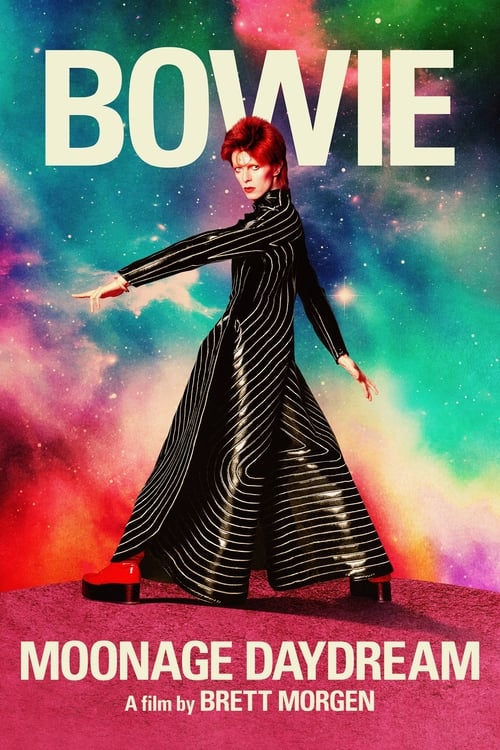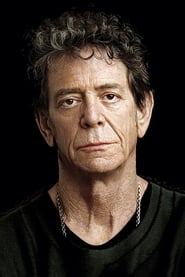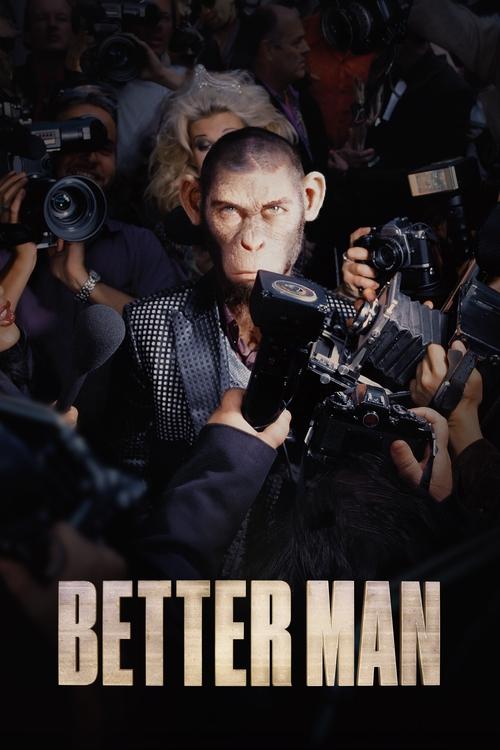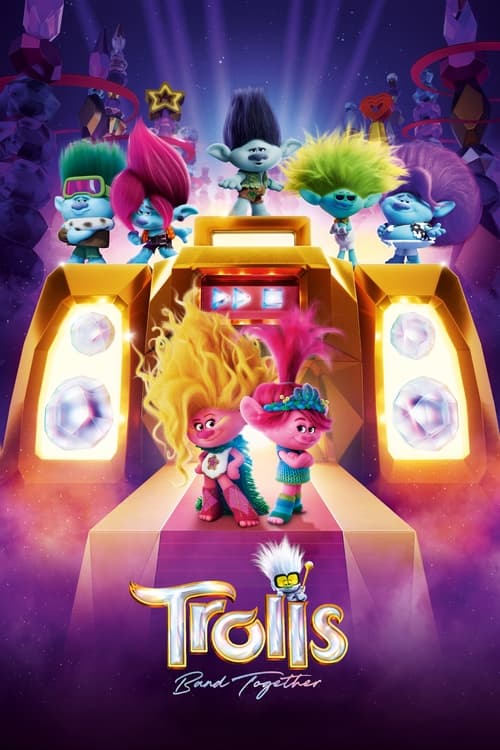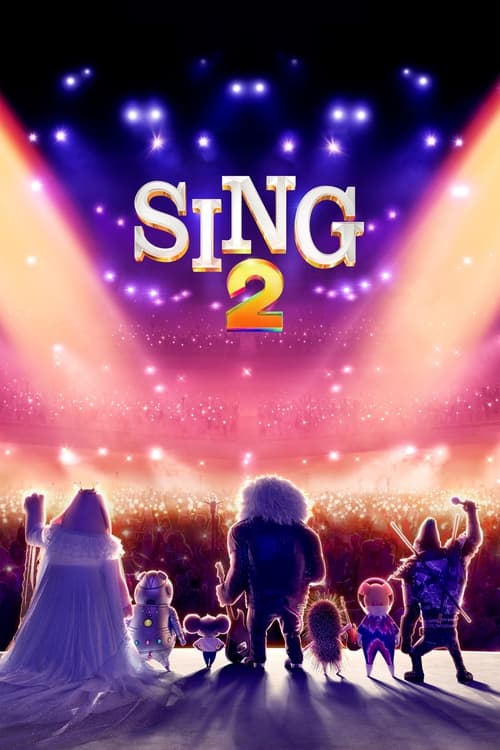
Ask Your Own Question
What is the plot?
As Moonage Daydream begins, the viewer is plunged into a philosophical and visually stunning world that sets the tone for the rest of the film. The opening sequence features a quote from David Bowie reflecting on Friedrich Nietzsche's famous proclamation that "God is dead," which Bowie uses to ponder human arrogance and existential confusion. This intellectual and artistic exploration is not just a starting point but a recurring theme throughout the documentary.
The screen erupts with a dizzying montage of space imagery--rockets soaring through the cosmos, robots, and star-gazers--interspersed with fragments of early silent cinema, 1920s science fiction, 1950s cartoons, and 1960s-70s newsreel footage. This cosmic and retro-futuristic imagery introduces Bowie as a figure of otherworldly creativity and transformation, setting the stage for an experiential journey through his life and art.
David Bowie himself is the central figure throughout the film, introduced through archival footage and voice-over interviews spanning decades. The film does not introduce other characters in a traditional narrative sense but focuses on Bowie's multiple personas and phases, such as Ziggy Stardust and his Berlin period. Bowie's voice guides the viewer through his thoughts and artistic evolution, offering insights into his philosophy and creative process.
As the film progresses, it covers Bowie's beginnings in London, where he first gained attention as a young musician. London represents the starting point of his musical and artistic journey, marked by early performances and the development of his unique style. Bowie's voice-over reflects on these early days, discussing the challenges of finding his place in the world and the importance of reinvention.
A significant portion of the film focuses on Bowie's time in West Berlin in the late 1970s. Here, Bowie explores interests beyond music, including oil and acrylic painting and literary arts. The film showcases his portrait work, highlighting his experimental use of color and style. West Berlin symbolizes a period of artistic reinvention and personal exploration, where Bowie delved into new forms of expression and challenged himself creatively.
The film also touches on Bowie's family background, including his half-brother Terry Burns, which provides context for his early life and influences. However, the focus remains on Bowie's artistic and philosophical journey rather than his personal relationships.
Throughout the documentary, various live concert footage and studio sessions appear, emphasizing Bowie's musical evolution and his impact on fans. These sequences are woven together with Bowie's voice-over, offering a glimpse into his thoughts on creativity, identity, and fame. The film does not depict fictional deaths or confrontations; instead, it explores internal struggles and philosophical questions Bowie faced, such as identity, fame, and creativity.
As Bowie navigates his career, the film reveals his deep engagement with existential philosophy, particularly Nietzsche's ideas about the death of God and the resulting human crisis. Bowie's reflections on these themes provide a rich backdrop for understanding his artistic choices and personal growth.
The climax of the film culminates with Bowie's emergence from a two-year hiatus, presenting himself as a refined, suave artist in tailored Savile Row suits. This final artistic reinvention symbolizes his mature, polished public persona, marking a new chapter in his career. The final scenes emphasize Bowie's mature persona and legacy, blending music, art, and cosmic imagery to leave the viewer with a sense of his enduring impact and enigmatic identity.
The film ends on an immersive, sensory note that encapsulates Bowie's lifelong quest for self-definition and artistic innovation. There is no traditional narrative climax or resolution; instead, Moonage Daydream concludes as an experiential odyssey through Bowie's life, art, and philosophy, using montage, symbolism, and Bowie's own voice to create a richly textured portrait of the artist. As the credits roll, the viewer is left with a profound sense of Bowie's legacy as a visionary artist who continuously pushed the boundaries of creativity and identity.
More Movies Like This
Browse All Movies →
What is the ending?
In the ending of "Moonage Daydream," David Bowie's journey culminates in a celebration of his life and artistry. The film concludes with a montage of Bowie's performances and personal reflections, emphasizing his impact on music and culture. The final scenes evoke a sense of transcendence, leaving viewers with a feeling of connection to Bowie's legacy.
As the film approaches its conclusion, the screen is filled with vibrant visuals of David Bowie's performances, interspersed with intimate moments from his life. The audience is taken on a journey through his evolution as an artist, showcasing his fearless experimentation with music and identity.
Scene by scene, the film transitions from Bowie's early days, where he grapples with his identity and the pressures of fame, to his rise as a cultural icon. The visuals are kaleidoscopic, reflecting the psychedelic nature of his music and the era he influenced.
In the final act, the film presents a series of Bowie's most iconic performances, each one a testament to his artistic genius. The energy of the crowd is palpable, and the camera captures the ecstatic faces of fans, illustrating the deep connection Bowie forged with his audience.
As the montage progresses, Bowie's introspective moments are highlighted, revealing his thoughts on mortality, creativity, and the human experience. He reflects on the transient nature of life and art, expressing a sense of peace with his journey.
The film culminates in a powerful performance of "Moonage Daydream," where Bowie's charisma and stage presence shine brightly. The visuals become increasingly surreal, blending reality with the fantastical, symbolizing Bowie's ability to transcend the ordinary.
In the final moments, the screen fades to black, leaving behind echoes of Bowie's voice and the lingering impact of his artistry. The film closes with a sense of celebration rather than sorrow, emphasizing that while Bowie may have left this world, his spirit and influence continue to resonate.
The fate of David Bowie, as portrayed in the film, is one of enduring legacy. He is depicted not just as a musician but as a visionary who challenged norms and inspired countless individuals. The film leaves viewers with a profound appreciation for his contributions to art and culture, reinforcing the idea that his essence lives on through his work and the lives he touched.
Is there a post-credit scene?
Moonage Daydream, the 2022 film directed by Brett Morgan, does not feature a traditional post-credit scene. Instead, the film concludes with a powerful and immersive experience that encapsulates David Bowie's artistic journey and legacy. The ending leaves viewers with a sense of reflection on Bowie's impact on music, art, and culture, rather than a specific scene or additional content after the credits. The film itself is a kaleidoscopic exploration of Bowie's life, filled with his music, visuals, and personal insights, creating a lasting impression without the need for a post-credit moment.
What are the key moments that showcase David Bowie's transformation throughout the film?
The film captures David Bowie's transformation through various key moments, such as his early performances in the 1960s, where he struggles to find his identity, leading to the creation of his alter ego, Ziggy Stardust. The film visually contrasts Bowie's flamboyant stage presence with his personal moments of vulnerability, such as his reflections on fame and the pressures it brings. Another pivotal moment is his collaboration with other artists, which highlights his innovative spirit and willingness to evolve artistically.
How does the film depict Bowie's relationship with his family and its impact on his career?
The film delves into Bowie's relationship with his family, particularly his bond with his half-brother Terry, who struggled with mental health issues. This relationship profoundly influences Bowie's artistic expression, as he grapples with themes of loss and identity. The emotional weight of these familial connections is portrayed through intimate scenes that reveal Bowie's deep-seated fears and motivations, shaping his music and public persona.
What role does the concept of space play in Bowie's artistic vision as depicted in the film?
Space is a recurring motif in Bowie's artistic vision, symbolizing both exploration and escapism. The film features stunning visuals of cosmic imagery, reflecting Bowie's fascination with the universe. This theme is particularly evident in songs like 'Space Oddity,' where the narrative of an astronaut mirrors Bowie's own feelings of isolation and longing for connection. The film uses these visual elements to create a sense of wonder and to illustrate how space influenced Bowie's creative process.
How does the film portray Bowie's struggles with identity and fame?
The film portrays Bowie's struggles with identity and fame through a series of contrasting scenes that highlight his public persona versus his private self. As Ziggy Stardust, Bowie experiences immense success, but this leads to feelings of alienation and confusion about his true self. The film captures his internal conflict through candid moments of introspection, where he questions the sustainability of his fame and the toll it takes on his mental health, ultimately leading to his decision to abandon Ziggy.
What are some significant collaborations featured in the film that shaped Bowie's music?
The film highlights several significant collaborations that shaped Bowie's music, including his work with producer Tony Visconti and guitarist Mick Ronson. These partnerships are depicted through studio sessions and live performances, showcasing the creative chemistry that fueled iconic albums like 'The Rise and Fall of Ziggy Stardust and the Spiders from Mars.' The film emphasizes how these collaborations not only influenced Bowie's sound but also contributed to his evolving artistic identity.
Is this family friendly?
"Moonage Daydream," produced in 2022, is a documentary film that explores the life and artistry of David Bowie. While it is a celebration of his music and creativity, there are several aspects that may be considered objectionable or upsetting for children or sensitive viewers:
-
Substance Use: The film includes references to drug use, which is a significant part of Bowie's life and artistic expression during certain periods.
-
Sexual Themes: There are discussions and depictions of Bowie's sexuality, including his relationships and sexual identity, which may not be suitable for younger audiences.
-
Mental Health Struggles: The film touches on Bowie's battles with mental health, including anxiety and depression, which could be distressing for some viewers.
-
Visual Imagery: The documentary features a variety of visual styles, including surreal and abstract imagery that may be confusing or unsettling for children.
-
Death and Loss: There are themes related to mortality and the impact of loss, particularly in relation to Bowie's own experiences and reflections on life.
Overall, while "Moonage Daydream" is a rich artistic exploration, its content may not be appropriate for all audiences, particularly younger viewers or those sensitive to the aforementioned themes.

